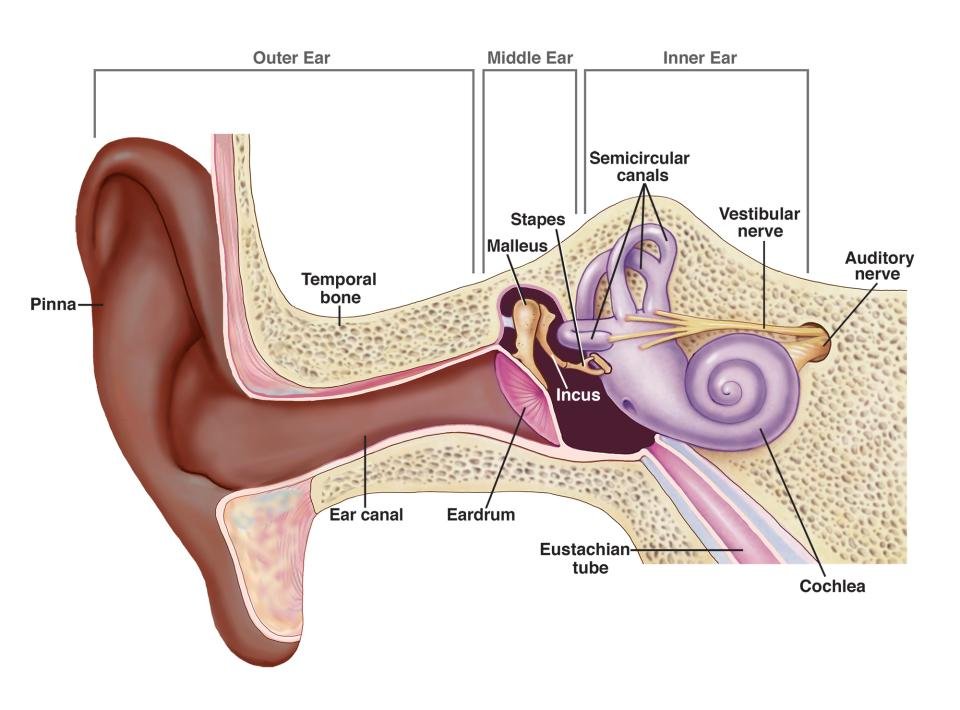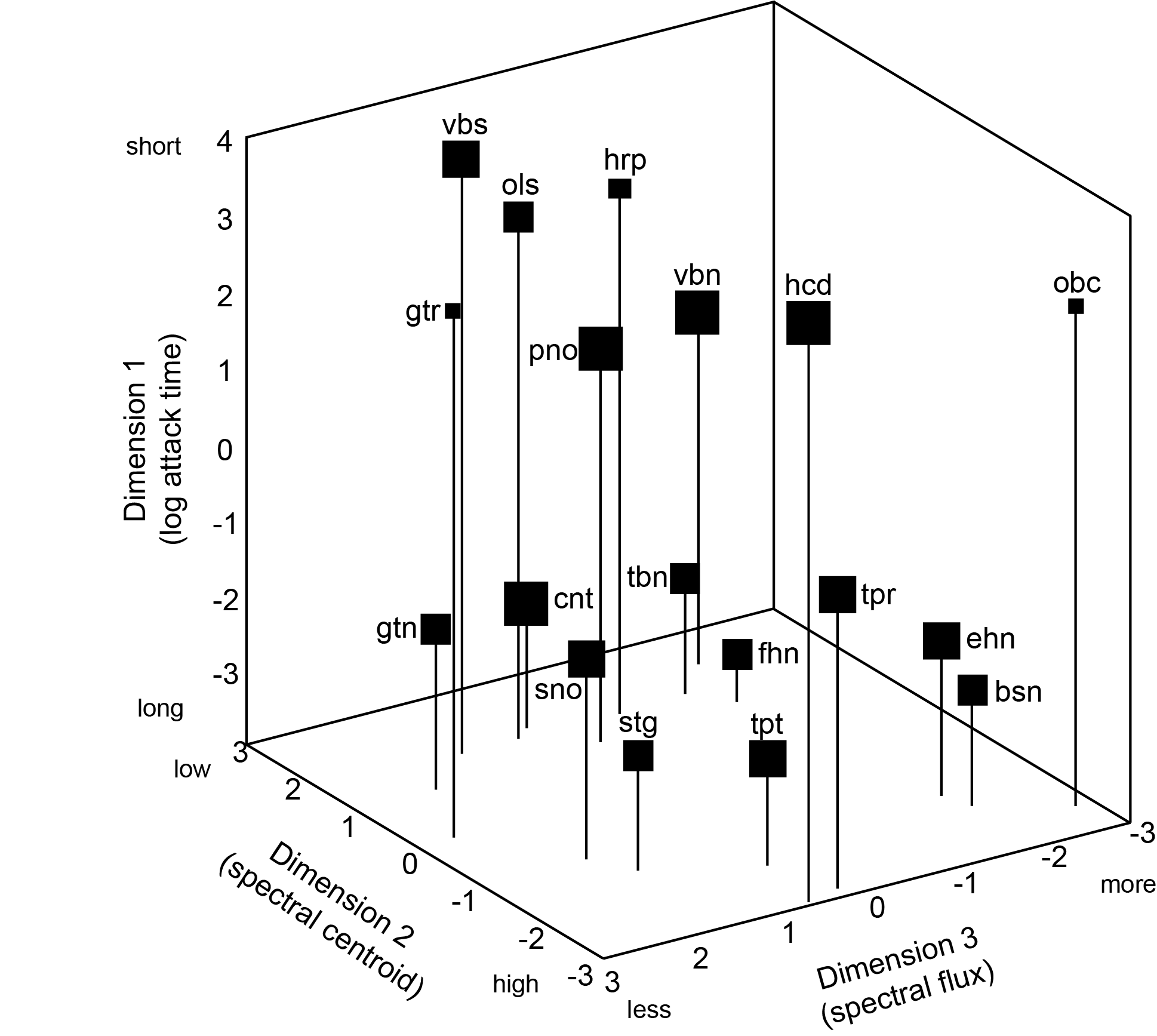

Klangfarbenmelodie
A compositional technique where a musical line or melody is split between several instruments, rather than being played by a single instrument. Each instrument plays a note or a short succession of notes, creating a continuous melody with a constantly changing timbre or "tone colour.”

Masking
Suppose you enter a restaurant with a friend, mid-conversation. As you enter, you are greeted by the background noise of other patrons’ conversations. You and your friend begin to speak louder so you can hear one another. You’ve just experienced masking, a very familiar yet fascinating phenomenon that many of us encounter every day without even noticing.

Spectral Envelope
In the process of analyzing the spectrum of a sound, it is sometimes useful to describe its spectral properties in terms of energy distribution rather than individually mapping all its components. In so doing, we invoke the concept of spectral envelope, a curve that can be obtained by successively connecting the peaks of the partials shown in the frequency representation of the sound (i.e., with frequency on the x-axis and energy or amplitude on the y-axis). Spectral envelopes are important factors in timbre perception. They reflect the acoustic properties of an object that produces sound in terms of the energy distribution across the frequency spectrum.

Spectrogram
Just as a frequency spectrum makes it possible to analyze the partials and noise components that make up a sound, a spectrogram can be used to visualize the evolution of these components of a sound over time. The first modern device able to produce such a representation of sound was the “sound spectrograph,” developed at Bell Telephone Laboratories in the 1940s [1]. A spectrogram has a very intuitive way of displaying its parameters. Just as in a musical score, time is represented on the x-axis, frequency on the y-axis, and energy/amplitude is determined by the intensity/hue of the colors.

Timbre Space
A sound’s timbre can be represented by a point inside a conceptual timbre space, a space where the axes are usually defined by the principal attributes (e.g., spectral centroid, attack time) that one would implicitly use to perceive or conceive any timbre in a given context. Timbre spaces are obtained using a statistical method called multidimensional scaling analysis (MDS), which generates a simplified multidimensional map from a series of perceptual distances between pairs of timbres (as measured in perceptual experiments). The experimenter then deduces the attributes (acoustic descriptors) that best describe the axes obtained. Timbre spaces provide us with complementary information to the neuro-cognitive mechanisms of timbre perception, and can also be a very useful compositional tool.

Seven Beginnings
Seven Beginnings (2019), for flute, oboe, clarinet, bassoon, horn, two violins, viola, and cello, was composed as a deliverable of my ACTOR postdoc. The piece builds upon the trend of speech transcription in recent music, with a focus on spectral transcription and cross-modal composition. But far from being a technical étude, it is a very personal piece with a very specific motivation behind its materials and methods.

The Unanswered Question – Charles Ives
In 1908, American composer Charles Ives composed The Unanswered Questionfor string orchestra, solo trumpet (or English Horn) and four flutes (or three oboes and one clarinet). This piece inspired Leonard Bernstein’s famous Norton Lectures of the same title at Harvard in 1973 and continues to capture the imaginations of musicians and audiences today….

Shepard Tone
In this post Auditory Scene Analysis, we introduced some of the ways that sound components are grouped together by the auditory system. This has many musical applications, and also lays the foundation for some interesting auditory illusions. One of the most famous is the Shepard Tone, named for cognitive scientist Roger Shepard, which creates an illusion of perpetual ascent or descent. A quick search on YouTube will turn up many examples; here is a handful:

Deus Cantando — Peter Ablinger
This week’s amazing moment in timbre is a bit of a mind-bender: a piano that recreates the timbre of the human voice. It’s Peter Ablinger’s Deus Cantando (2009). for a piano being played by a computer-controlled mechanical device. Watch and be wowed:

Auditory Scene Analysis
This is a spectrograph, a way of visualizing sound in which the y axis represents frequency, the x axis represents time, and darkness or colour represents concentration of energy. Looking from bottom to top shows how the sound energy is distributed on the continuum from low to high, and looking from left to right shows how that distribution changes over time...


Dripsody — Hugh Le Caine
Our second Amazing Moment in Timbre is another classic, but somewhat lesser-known. It’s Canadian composer and inventor Hugh Le Caine’s Dripsody(1955).

Atmosphères — György Ligeti
We’re beginning our “amazing moments in timbre” series with a true classic, György Ligeti’s paralyzingly beautiful orchestral masterpiece Atmosphères(1961)…

Partial
Although we may perceive sounds such as musical notes as singular, self-contained units, the physical reality often suggests something very different. Most sounds we hear are actually complex mixtures of many different sound components, some of which are noisy and transient, others of which may have stable frequencies…
